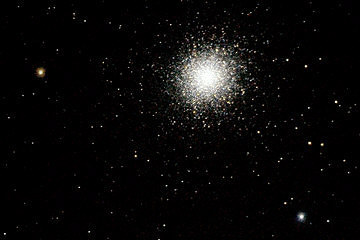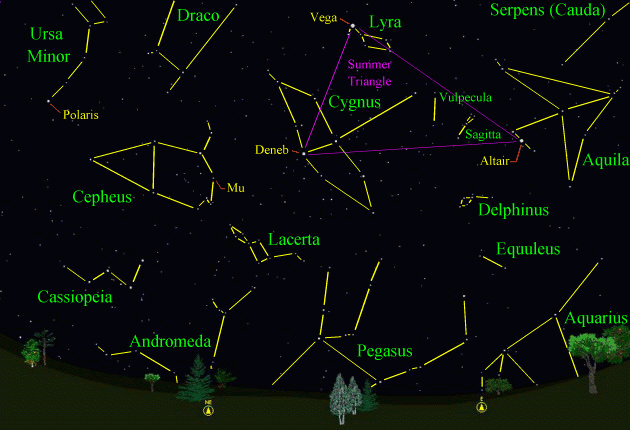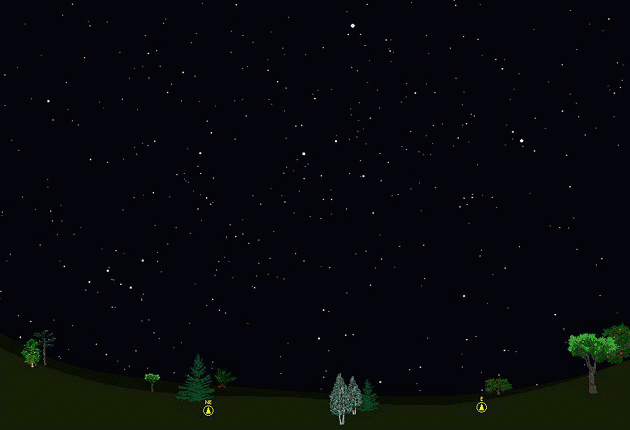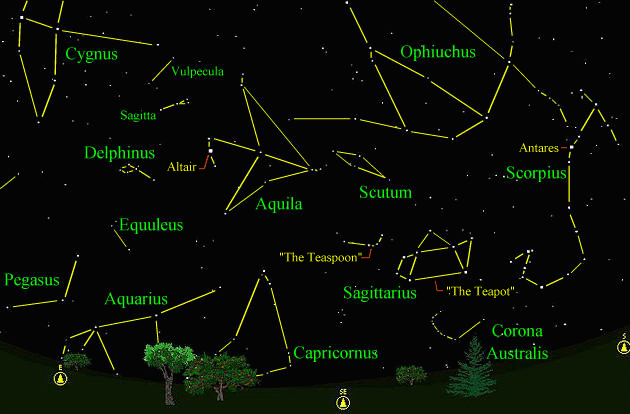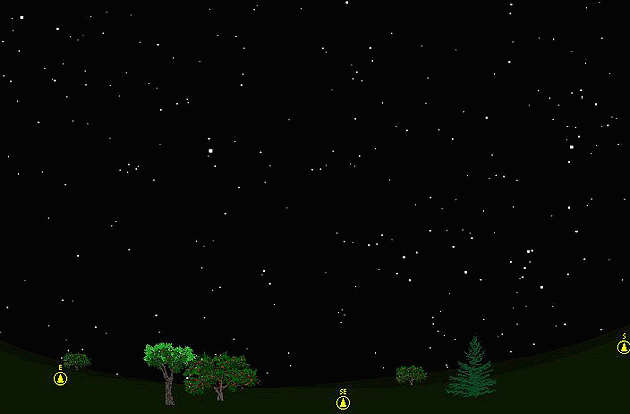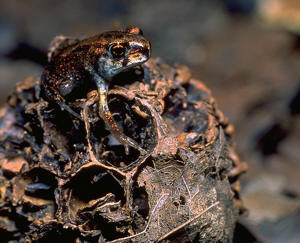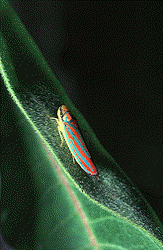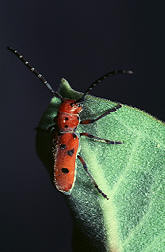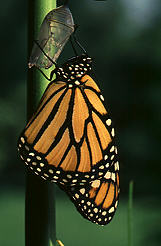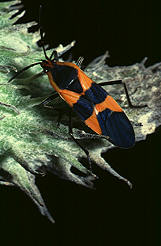The purpose of this feature is to give scout leaders, educators and naturalists an idea of some of the natural events coming up each month. We will try to cover a variety of natural events ranging from sky events to calling periods of amphibians, bird and mammal watching tips, prominent wildflowers and anything else that comes to mind. We will also note prominent constellations appearing over the eastern horizon at mid-evening each month for our area for those who would like to learn the constellations. If you have suggestions for other types of natural information you would like to see added to this calendar, let us know! Note: You can click on the hyperlinks to learn more about some of the featured items. To return to the Calendar, hit the "back" button on your browser, NOT the "back" button on the web page. All charts are available in a "printer friendly" mode, with black stars on a white background. Left clicking on each chart will take you to a printable black and white image.
Notes and Images From June 2006 A Serene and Moonless Night
We ran our Tennessee Amphibian Monitoring Program route in the south Cumberland Mountains on June 14th. A cold front had passed through the night before and, although the conditions were not ideal for amphibians, we had a really pretty night sky, with no moon to diminish the starry show. While listening to Cope’s Gray Treefrogs, American and Fowlers Toads, Bullfrogs and Green Frogs, I looked overhead to see if I could spot the great globular cluster M-13 in the constellation Hercules. I soon spotted the faint glow of the cluster, along with several 6th magnitude stars nearby. M-13 was discovered in 1714 by Edmund Halley of Halley’s Comet fame. He wrote of the cluster, “this is but a little Patch, but it shews itself to the naked Eye, when the Sky is serene and the Moon Absent.” M-13 is obvious in binoculars, as are the two 7th magnitude stars that flank it in the image above. My favorite view of M-13 was from the campground at Luna Lake in Eastern Arizona, at an elevation of 8,000 feet. Globular clusters are truly glorious sights in a large telescope. Robert Burnham, author of Burnham’s Celestial Handbook, told of seeing the globular cluster M-5 through the 40-inch aperture reflector of the U.S. Naval Observatory at Flagstaff, Arizona. Burnham wrote;
Several hundred thousand stars make up the cluster, which is about 140 light-years in diameter. The distance to M-13 is estimated to be around 25,000 light-years. Those living on an earth-like planet within a globular cluster would see a sky filled with stars as bright as the brightest stars in our night sky. There is a price to pay for such a view, however. Because of scattered light, the sky would never get darker than a twilight sky. For those sky-watchers, there would be no fainter stars visible, no Milky Way vaulting overhead. Far from city lights, it is the very darkness of our sky background that makes our earthly views so stunning. For information on outdoor lighting practices that will allow future generations here on earth to still see the Milky Way, you may want to visit the International Dark Skies Association website. To find the constellation Hercules refer to the star chart for April, which also shows the position of M13 within the constellation. M13 is directly overhead on the following dates and times: July 1st, 10:48pm, July 15th, 9:53pm, July 30th, 8:50pm. Again, binoculars will make your search easier. When looking for the cluster with the naked eye, try using "averted vision", looking to one side of the cluster. This allows the cluster's light to fall on the more light-sensitive rods in your eye's retinas, and will make it more visible.
A Phantom Among the Pines In early June we did wildlife inventory work near Anniston, Alabama. On driving through one pine habitat, I remarked that it reminded me of habitat where I had seen and heard Bachman’s Sparrow. About an hour later, as we were finishing our work in the area, we heard the faint, beautiful song of a Bachman’s! It is one of my favorite sparrow songs, starting out with a beautiful high, clear sustained first note, then followed by a trill. Early the next morning we returned with our recording equipment to tape it. You can hear the Bachman’s Sparrow’s song by clicking the above image (796KB). In the background sounds on the recording are the "squeaky toy" notes of a Brown-headed Nuthatch, as well as a Blue Grosbeak. Bachman’s Sparrows can be rather shy, and despite a couple of attempts, we were able to get only a fleeting glimpse of the singer.
We found this Striped-neck Musk Turtle, (Sternotherus minor) at a natural spring near Anniston. The clear waters of the spring allowed us to image the turtle beneath the water’s surface. These small turtles have a carapace about 4” long. Prey include freshwater mollusks, insects and crayfish. This species can remain submerged for long periods of time because of its ability to obtain oxygen from the water via the moist linings of the mouth and throat.
A Rainbow After Sunset These summer afternoon thunderstorms create great opportunities for seeing rainbows. On June 2nd, while we were in Anniston, Alabama, I came out of a grocery store and saw a reddish colored rainbow from the parking lot. We were planning on doing some wildlife survey work that night, and I had already checked the sunset time and knew it to be 7:49pm. Glancing down at my watch I saw the time was 7:53pm. I ran over to a place where I had a flat western horizon, and, sure enough, the sun had already set. The rainbow continued to be visible for a few minutes more before it faded away. A look at my reference book for such events, Minnaert’s, Light and Color in the Outdoors, indicates that such rainbows are not too uncommon, and usually are reddened by the absence of shorter wavelengths of light from the setting sun due to atmospheric absorption. For more about rainbows, see “Somewhere Over Roy G Biv.”
Sky Events for July 2006: Evening Sky: Jupiter shines brightly in our evening skies and is about due south at dusk at the beginning of the month. It will appear in the twilight sky before any other star-like object this month. On July 5th Jupiter is about 5 degrees north of the waxing gibbous moon. You may want to see if you can spot the new red spot on Jupiter (see June 2006 Natural Calendar for details). To see when it's visible you can use Sky & Telescope's Red Spot Calculator - add one hour to the time given to find when the new spot is front and center. Mars is in the western sky at dusk, in Leo. Saturn remains in Cancer, and is getting lower and harder to see this month. Morning Sky: Bright Venus sinks progressively lower in the eastern dawn sky as the month progresses. The crescent moon occults the Pleiades on the morning of July 20th. The moon will start occulting stars in the early morning hours and will not have completely exited the cluster by dawn. All times noted in the Sky Events are for Franklin, Tennessee and are Central Daylight Time. These times should be pretty close anywhere in the mid-state area.
Constellations: The views below show the sky looking east at 9:50pm CDT on July
15th. The first view shows the sky with the constellation outlined and
names depicted. Star and planet names are in yellow. Constellation
names are in green. The second view shows the same scene without
labels. Looking to the east, see if you can spot the constellations of Cygnus,
the Swan, Lyra, the Lyre and Aquila, the Eagle. The bright stars Deneb,
Altair and Vega form the "Summer Triangle."
If you locate them first, you will have an easier time finding the
constellations around them. Below and to the left of Altair is the
constellation of Delphinus, the Dolphin, looking like it's leaping over the
faint stars of Equuleus, the Foal.
Above Delphinus look for the arrow-like form of Sagitta, the
Arrow. Between Sagitta and Cygnus lie the faint stars of Vulpecula,
the Fox. Looking northeast, see if you can pick out Cepheus, the
King. Mu Cephei, nicknamed the “Garnet
Star” by William Herschel, is a beautiful deep red star in binoculars or a
small telescope. Below and to the right
of Cepheus look for the faint stars that make up Lacerta, the
Lizard. Below and to the left of Cepheus, look
for Cassiopeia. Looking to the southeast, the brightest stars of Sagittarius,
the Archer, form a grouping nicknamed, "The Teapot."
Look for them above the southeast horizon. On very clear summer nights,
the bright portions of the Milky Way above Sagittarius look like steam
rising from the spout of the teapot. If you look just to the right of the
spout of the teapot, you will be looking in the direction of the center of our
galaxy. The little grouping of stars to the left of Sagittarius is
nicknamed, "The Teaspoon." Below The Teapot, look for Corona Australis, the
Southern Crown. All of the constellation Scorpius,
the Scorpion, with its bright star Antares, should now be above the
horizon in the southeast. Also in the
southeast and above Sagittarius, look for the faint stars of Scutum.
On Learning the Constellations: We advise learning a few constellations each month, and then following them through the seasons. Once you associate a particular constellation coming over the eastern horizon at a certain time of year, you may start thinking about it like an old friend, looking forward to its arrival each season. The stars in the evening scene above, for instance, will always be in the same place relative to the horizon at the same time and date each July. Of course, the planets do move slowly through the constellations, but with practice you will learn to identify them from their appearance. In particular, learn the brightest stars (like Altair and Vega in the above scene looking east), for they will guide you to the fainter stars. Once you can locate the more prominent constellations, you can "branch out" to other constellations around them. It may take you a little while to get a sense of scale, to translate what you see on the computer screen or what you see on the page of a book to what you see in the sky. Look for patterns, like the stars that make up the constellation Lyra. The earth's rotation causes the constellations to appear to move across the sky just as the sun and the moon appear to do. If you go outside earlier than the time shown on the charts, the constellations will be lower to the eastern horizon. If you observe later, they will have climbed higher. As each season progresses, the earth's motion around the sun causes the constellations to appear a little farther towards the west each night for any given time of night. If you want to see where the constellations in the above figures will be on August 15th at 9:50pm CDT, you can stay up till 11:50pm CDT on July 15th and get a preview. The westward motion of the constellations is equivalent to two hours per month. A good book to learn the constellations is H. A. Rey's classic, The Stars, A New Way to See Them. Rey's depictions of the constellations and witty commentary are terrific. A good general reference book on astronomy is the Peterson Field Guide, A Field Guide to the Stars and Planets, by Pasachoff. The book retails for around $14.00. My favorite books about astronomers are Richard Preston's First Light, and the wonderful Starlight Nights, by Leslie Peltier. A good beginners software program for learning the night sky is the Starry Night Beginner program. Visit the Starry Night web site at www.starrynight.com The program retails for around $30.00 and contains a wealth of information.
Amphibians:
July’s frogs and toads are much like June’s. Listen for Cope's Gray Treefrogs, Gray Treefrogs, Bird-Voiced Treefrogs, Green Treefrogs and Barking Treefrogs. Northern Cricket Frogs and Southern Cricket Frogs call a lot during July, and the calls of Bullfrogs and Green Frogs fill the night air. After heavy rains listen for the high, insect-like call of the Eastern Narrowmouth Toad and the strange-sounding Eastern Spadefoot. Be sure to look closely at young toads you encounter. Sometimes we find young Eastern Spadefoots foraging during the day. A young Eastern Spadefoot will have vertical pupils, a tiny spade on its rear feet and will often have some red warts, even when only a fraction of an inch long. A hand lens helps to see these features (or turn your binoculars around and use them for a magnifying glass.)
By the end of June and the beginning of July, many of the players
in the summer insect orchestras have started performing. Cicadas are calling now during the day and
at dusk, and True Katydids evoke memories of past summer evenings with their familiar
song. Fork-tailed Bush Katydids give their short upward-slurred rasps. Coneheads play their far-ranging,
long monotone rasps, the pitch Doppler-shifting
downward as you drive by them in the dark, and fireflies mirror the stars
overhead with their gentle light. By day, some of the more colorful insects can
be found in patches of milkweed.
Monarch butterflies lay their tiny cream-colored
eggs on the milkweed leaves
and you can usually find a Monarch caterpillar munching on the foliage. If you’re lucky, you might even find the
beautiful, jewel-like chrysalis of the Monarch nearby. To see a Monarch caterpillar form it's chrysalis,
click
here. Scarlet and Green Leafhoppers, Large
Milkweed Bugs and Red Milkweed Beetles all add their brilliant warning colors
to the scene.
To
learn more about insect songs we recommend: Songs of Crickets and Katydids of the Mid-Atlantic States, by Rannels, Hershberger and Dillon Archives (Remember to use the back button on your browser, NOT the back button on the web page!) Natural Calendar February 2006
Natural Calendar
December 2005
Natural Calendar
November 2005
Natural Calendar
September 2005
Natural Calendar
February 2005
Natural Calendar
December 2004
Natural Calendar
November 2004
Natural Calendar
September 2004
Natural Calendar
February 2004
Natural Calendar
December 2003
Natural Calendar
November 2003
Natural Calendar
September 2003 Natural Calendar February 2003 Natural Calendar December 2002 Natural Calendar November 2002 Nature Notes Archives: Nature Notes was a page we published in 2001 and 2002 containing our observations about everything from the northern lights display of November 2001 to frog and salamander egg masses. Night scenes prepared with Starry Night Pro software All images and recordings © 2006 Robert English, Leaps |
